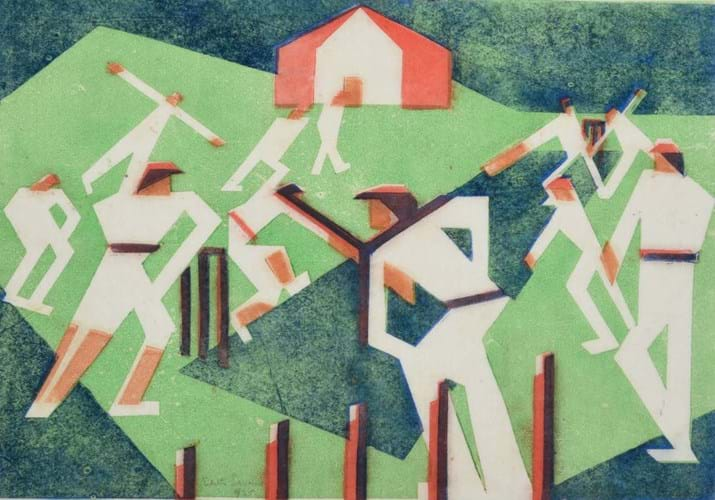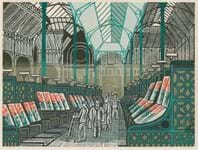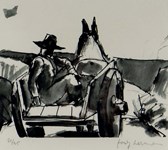But while the futuristic impressions by the likes of Claude Flight, Cyril Edward Power and Sybil Andrews have become scarcer, a few other names have now emerged and have become a more attainable option for those on a budget.
One such artist is Edith Lawrence (1890-1973), whose prints tend to sell in the low thousands rather than the £10,000-plus levels for the majority of prints by Flight, for example. Her life and work is closely tied in with Flight’s – the two artists became lifelong partners after she studied under him at the Grosvenor School and they set up an interior decoration studio together in 1927.
The style of her linocuts is vintage Grosvenor – bright colours, stark backgrounds and angular shapes – although her subject matter was at times removed from the depictions of the mechanised world favoured by other members of the group. Indeed, many of her linocuts were produced from watercolours she made during her travels in Britain and Europe, and so retain a slightly different but more individual feel.
In July 2016, a group of 80 Grosvenor School works came to Tennants (20% buyer’s premium) having remained as part of Lawrence’s estate. Consigned to the North Yorkshire auction house by her great-nephew, the sale helped to give her more exposure on the secondary market and raise her profile in general.
“Very few artworks by Edith Lawrence had appeared on the market before we started to sell the estate,” said Tennants’ picture specialist Francesca Young. “They are certainly very popular and collectable among Grosvenor School and Modern British collectors and her name is rightly beginning to achieve the recognition it deserves.” More recently, a further nine works from the same source appeared at the Leyburn saleroom on March 6, all of which sold for a combined hammer total of just over £11,000. The top sums were fetched by the five linocuts on offer.
Sporting scenes
Leading the pack was a copy of Cricket, a linocut from 1929 that is Lawrence’s best-known print. Signed and measuring 12 x 14½in (30 x 37cm), it was from an edition of 25. Estimated at £3000-5000, it sold at £4000 to a UK private buyer – a sum below the £6200 made by a copy in the July 2016 sale, perhaps due a larger number of examples emerging on the market in the last five years.
A copy of France from c.1931, a 10½ x 14in (26.5cm by 35cm) signed linocut from an edition of 50, drew good interest too against a guide of £1200-1800. It sold at £2400 to a private buyer – a sum that was above the £1900 for another copy sold at Tennants in February 2020 but below the £5200 for the copy sold in the 2016 sale.
Another rustic subject was Houses and Trees, which was a slightly smaller linocut from an edition of 50. It sold within estimate at £1800, again being knocked down privately.
Elsewhere at the sale, another print on offer was a William Scott (1913- 89) lithograph.
As with other artists, Scott’s prints followed his main themes which, in his case, was the representation of simple objects in flattened form. While his paintings can easily fetch six-figure sums, plenty of printed material can be picked up for under £5000.
Pears, a 20in x 2ft 4in (50 x 65cm) signed print from 1979 (edition of 150) was a typical example. Against a £2000-3000 estimate, it sold at £2400.
Specialist’s view
Francesca Young, picture specialist at Tennants said: “Buying prints is a great entry level into collecting. They are wonderful artworks in their own right and a fantastic way to own an iconic image by a leading artist such as Banksy, Lowry, Francis Bacon or William Scott, to name a few we have recently sold.
“We’ve certainly seen a rise in the popularity of Modern and Contemporary prints in recent years. Perhaps this is due to changing attitudes to Modern art and printmaking and the nature of how people are furnishing their homes.
“The market is very buoyant. Prices have been exceptionally strong in lockdown across the board.”

















